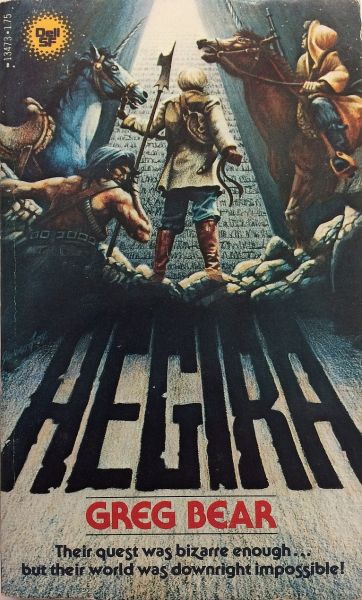Runnin’ Low on Faith And Gasoline
Hegira
By Greg Bear

27 Nov, 2022
Because My Tears Are Delicious To You
0 comments
Greg Bear’s 1979 Hegira is a stand-alone far-future megastructure science fiction novel. Hegira was Bear’s debut novel.
A structure far larger than fabled Earth, Hegira is home to a multitude of human cultures. In other contexts, worlds of Hegira’s scale might have ensured that communities diverged radically from each other. Hegira has obelisks, which have made all the difference.
Dotted across the planet’s surface at five-thousand-kilometer intervals, the obelisks are a thousand kilometers high. Humanity’s history (and associated technologies) are recorded on their sides, arranged chronologically with the earliest events at the bottom and the most recent at the top. Cribbing from the obelisks provides a shortcut to technological progress while ensuring that the cultures of Hegira recapitulate the cultures of old Earth. To date, only the lowest sections of the structures have been reached, limiting the Hegirans to 20th century technology at best.
The great warlord Sulay has led his legions on a fifty-thousand-kilometer campaign of conquest and bloodshed. In the course of invading and sacking whole nations, his army has been reduced from two million people to ten thousand. Sulay’s army will pay for its crimes. Sulay’s subordinate Bar-Woten, knowing that doom is nigh, flees before the army’s enemies gather the courage to attack.
Bar-Woten is accompanied by two men: freed slave Barthel (formerly named Amma bin Akka)1, and conflicted religious fanatic Kiril. Kiril is on a quest to save his one true love from a mysterious curse that left her immobile and seemingly lifeless. The quest requires travelling beyond the edge of the known world. Since the known world is where Bar-Woten’s enemies live, Bar-Woten elects to accompany Kiril. If nothing else, Bar-Woten will learn more about the bizarre world on which he lives.
The trio pursue the quest at an unusual moment in Hegira’s history. Hegira was created for a purpose. Its goal is almost at hand. Hegira and its inhabitants will have to change radically to suit the new era that is dawning.
Across the giant world, the immense obelisks begin to topple. Millions die. The survivors are left to ask why.
One of the trio will learn the answer.
~oOo~
The lesson learned in the course of this review: if one impulsively decides to review a recently deceased author’s fiction to commemorate their demise, perhaps it would be better NOT to start with their very first novel. Bear did improve markedly over the course of his lengthy career.
Youthful readers may wish to know before starting that this is a novel about a stalker. A character embraces a great quest to win the hand of a woman, go him! That same character is surprisingly uninterested in how she feels about this; he has quested and he deserves her, somewhat less go him! Well, it was a different time.
Unusually for a mass market paperback of this era, the novel has illustrations. The printing technology of the day was not up to the task of reproducing Fabian’s art. What I assume were competent illustrations in the original are muddy and indistinct in the novel.
Readers will be unsurprised to learn that Hegira is an artifact. There is a rule with megastructures that to experience them is to commit to extremely long journeys, often on foot. Hegira is no exception. The scale of the distances covered is mind-boggling. Luckily for the protagonists, the transport technology available improves considerably over the course of the novel2.
Reading it, one gets the sense Bear had recently read works like Ringworld, Riverworld, Farthest Star, and Rendezvous with Rama and wanted to make his own contribution to the artifacts-of-unusual-size genre. I am sad to say that the novel is a hot mess.
A question about the megastructure novels: why anyone would build one? Often this is left as a tantalizing mystery: see Ringworld, Riverworld, Farthest Star, and Rendezvous with Rama. Sometimes, the author cannot resist the urge to explain what it was all about. Explanation is almost always a bad decision. See the sequels to Ringworld, Riverworld, Farthest Star, and Rendezvous with Rama. Well, perhaps it would be a good idea not to visit the sequels3…
Bear appends a lengthy explanation at the end of the novel. There are reasons why Hegira’s designers made the choices they made, but one cannot help but feel their approach was extremely convoluted, needlessly inhumane, and mainly aimed at providing a pretext for heroic quests. Had I been the quester in question, I would have asked to speak with the manager.
Ah well. At least the travelogue elements are diverting and the novel serves as an example of just how much plot a determined author could cram into a slender novel, in the olden days before word processors facilitated uncontained book bloat.
Hegira is available here (Amazon US), here (Amazon Canada), here (Amazon UK), here (Barnes & Noble), here (Book Depository), and here (Chapters-Indigo).
1: Bar-Woten graciously frees Barthel before the quest begins. However, since Bar-Woten was the one who murdered the boy’s entire family before renaming and enslaving him, freeing him is the least he could do.
Bar-Woten would prefer that Barthel not know about Bar-Woten’s role in Barthel’s family’s deaths, as the revelation would only lead to an uncomfortable conversation. In Bar-Woten’s defense, well, he killed thousands of people over the course of his career. What’s a few more?
2: The catch being the better the technology, the greater the odds that the owners are genocidal imperialists.
3: You will note I’ve never reviewed the sequels in question.
